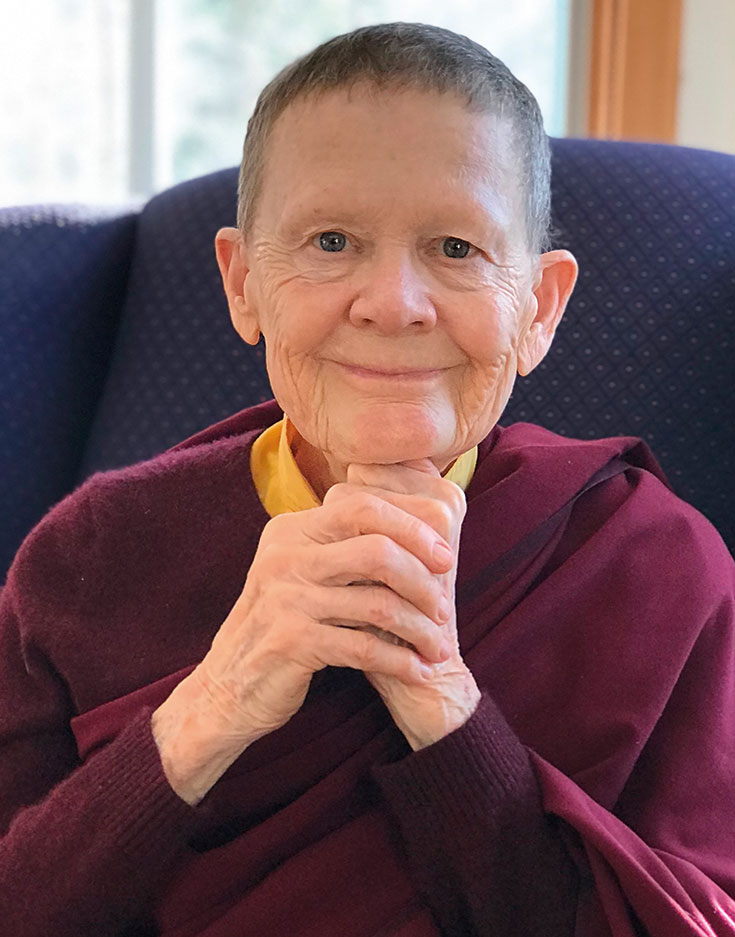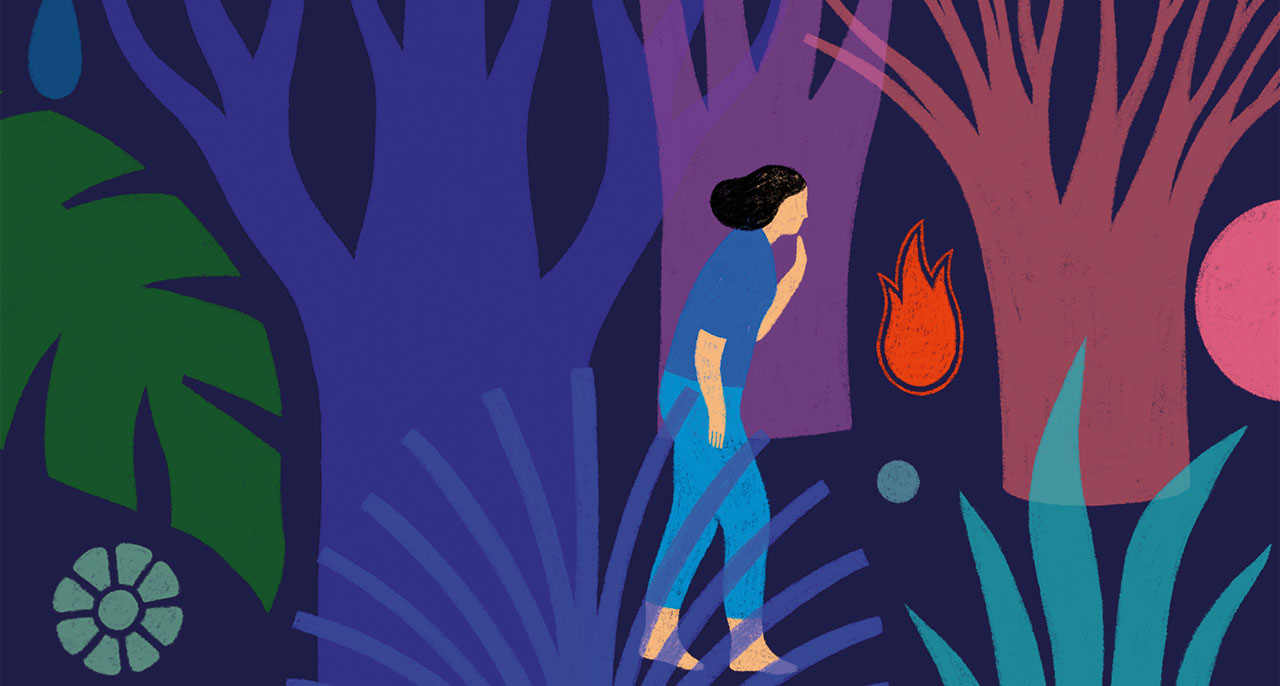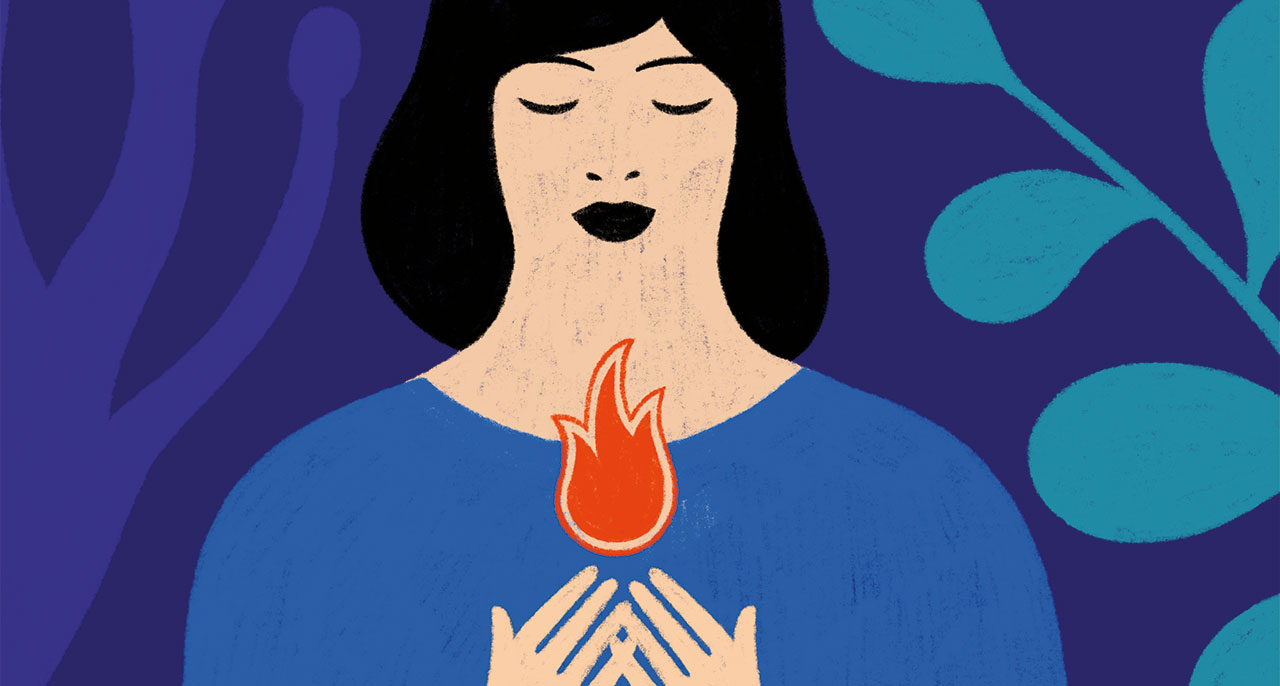1. Drop into Your Body
“Start with physical sensations because they’re relatively straightforward and provide a good access point to the emotions. Notice how your body is feeling.”
The dharma tells us that all our experiences of discomfort, anxiety, being disturbed, and being bothered are rooted in our kleshas. This Sanskrit term means “destructive emotions” or “pain-causing emotions.”
The three main kleshas are craving, aggression, and ignorance. The first two don’t require much explanation. “Craving” becomes a destructive emotion when it gets to the point of being an addiction or an obsession. I was once given some Asian candy whose brand name was “Baby Want-Want.” That sums up craving quite nicely, I think. We think something will bring us pleasure or comfort, so we become obsessed with having it or keeping it. “Aggression” is the opposite: we want to get rid of something that we perceive as a threat to our well-being.
“Ignorance” as a destructive emotion is a little harder to understand. It’s a dull, indifferent state of mind that actually contains a deep level of pain. It can express itself as being out of touch, being mentally lethargic, not caring what we’re feeling or what others are going through. When this state of mind dominates us, it can turn into depression.
These three kleshas are often called the “three poisons” because, as the Tibetan teacher Anam Thubten says, they kill our happiness. This often happens to us in two ways. First, we suffer while we experience anger, addiction, depression, jealousy, and the rest; then we continue to suffer as a result of the harmful actions they provoke.
You probably have firsthand experience of being unhappy when these poisons arise in your life. But how exactly do they kill your happiness? According to the Buddha’s teachings, it’s not the emotions themselves that make us suffer. In their raw form—before we start to struggle with them and before our thinking process gets involved—they are just sensations or forms of energy. They are not intrinsically bad or good. This is important to remember. The destructive aspect of aggression, for instance, is not the sensation; it’s our rejection of that sensation and what we then do as a response. The culprit isn’t the basic energy but the spin-off, what the Buddhist teacher Sharon Salzberg calls “the add-ons.”

When klesha energy arises, we tend to react in one of a few ways. One is to act out—either physically or with our words. Another is to suppress the emotion, to go numb around it; this may involve diverting our attention elsewhere, say by zoning out with Netflix.
A third common reaction is to get mentally wrapped up in some kind of storyline, one that often involves blame. All these reactions are based on our not being able to bear the discomfort of the energy. We have a propensity to be bothered by this energy, so we try to escape our discomfort by getting rid of what’s causing it. This approach is similar to that of the tyrant who kills the messenger bringing bad news instead of relating to the message. But when we indulge in any of these reactions, we only strengthen our pain-causing habits and perpetuate our misery in the long run. Somehow this is a hard lesson to learn.
Everyone has these habits. There’s no need to blame ourselves or anyone else for this process. Instead of blaming or feeling helpless, we can apply time-tested methods for working with our emotions constructively. Like everything else in the universe, the kleshas and our reactions to them are impermanent and insubstantial. This is what makes it possible for us to change our habits.
In general, lack of awareness is what gives our emotions their power. Bringing awareness to them is the magic key. When we’re aware of what’s happening, they lose their ability to make us miserable.
The first step in every method of working with emotions is simply to recognize what’s happening. One of the characteristics of the kleshas is that they tend to go undetected. We only notice them when they’ve become full-blown. We’re unaware of the emotion while it’s just an ember; by the time we smell the burning or feel the fire’s heat, it’s too late. We’ve struck out in words or actions, or we’re already on a binge.
Here is a fairly common example of the life cycle of a klesha. You catch a glimpse of someone in the hallway, someone you have issues with. You experience a faint tension in your shoulders or a subtle tug in your chest. This is the ember stage.
Next thing you know, you’re having judgmental or resentful thoughts about the person. This stage is like when logs in a wood stove have caught fire. There’s a lot more heat than at the ember stage, but at least it’s still contained. Even this level may go unnoticed. But if you keep unconsciously escalating your storyline, it’s as if you’re pouring kerosene on the fire.
Eventually it will be too much for the stove to contain and it might even burn down your house. At that point, you and everyone else will notice, but it will be too late to prevent a great deal of unavoidable pain. The damaging text message has been written, you’ve already pressed “Send,” and there’s no way to take it back.
Even then, there are ways of making the situation better and ways of making it worse. At every moment, we have these two basic alternatives. We can escalate or deescalate our misery. We can strengthen unhelpful habits or ventilate them. By becoming more conscious of what’s happening, we can put out the fire at the ember stage or the wood-stove stage and save ourselves and others so much grief.
Having a regular meditation practice makes us more aware of what’s happening in our mind, the mental undercurrent that tends to go unnoticed when we’re caught up in our daily activities and interactions. With meditation, we begin to catch some of the ember-like thoughts and subtle emotions that, left undetected, escalate before we notice them.

2. Bring Your Attention to Where You Are Right Now
“The trick is to stay present with the energy without acting out or repressing.”
Once we’ve become conscious of the klesha, the next step is to let ourselves feel it—to feel what we’re feeling. It sounds very simple, but for many people, this is quite challenging. Some people have difficulty because they’ve been traumatized. Others have certain emotions that, for whatever reason, they just don’t want to face. But, like all the other instructions in the dharma, feeling what you’re feeling is a practice. There are ways to train in it, to make gradual progress.
First, start with physical sensations because they’re relatively straightforward and provide a good access point. How do you feel physically? When we’re out of touch with our body, our kleshas have a greater opportunity to run rampant. On the other hand, when we’re present and embodied, it’s easier to be in touch with our mind. So notice how your body is feeling—the aches and pains and itches, the sensations of heat and cold, the places where you feel tight or relaxed.
Then look at your state of mind. Is it discursive or settled? What kind of mood are you in? What emotions do you notice? Here it’s very important to have an attitude of curiosity and openness rather than judgment. Different things can come up when we allow ourselves to feel what we feel. We may have painful memories or intensely unpleasant emotions. That’s to be expected and is no problem. But don’t push too hard and make this into an endurance trial. The training should take place, as much as possible, in an atmosphere of acceptance.
To grow in the ability to know what to do when an emotion grabs you, it’s helpful to remember three words: embodied, present, and kind. Drop into your body, bring your attention to where you are right now, and be kind. When there’s an upsurge of emotion, these three words can help you to deescalate. The main instruction is to stay conscious and, as Tsoknyi Rinpoche has said, “You have to be willing to feel some discomfort.”

3. Be Kind to Yourself
“I’ve discovered that when I’ve allowed myself to feel what I feel, I become more patient with myself and more forgiving.”
I’ve discovered over time that whenever I’ve allowed myself to feel what I feel, I become more patient with myself and more forgiving. Each time, I find myself able to relax with the feeling a little longer. And here’s the thing: while kleshas cause pain, the klesha energy itself is a limitless source of creative power, like an electric current. It’s not something you want to get rid of. The trick is to stay present with that energy without acting out or repressing. Doing this—or rather, learning to do this—you might find out something remarkable. In the basic energy of the kleshas, we find wisdom—ungraspable, egoless wisdom—free of grasping and fixation.
One of the most important ways to work with our emotions is to use them as a path of awakening. The idea is to allow ourselves to experience the energy of the kleshas fully and directly. In doing so, we discover that they contain all the wisdom we need to wake up. An unshakeable confidence comes from this experience.
We all come into this world with co-emergent unawareness, which is a basic misunderstanding about how things are. We believe we have some kind of stable identity, something that makes “me” me—something separate from the rest. Based on this misunderstanding, we find ourselves constantly getting hooked by the myriad pleasures and pains the world has to offer. Our mind gets completely wrapped up in kleshas and all the trouble that goes along with them. The teachings say that this painful process will continue until we wake up from our unawareness completely, until we see ourselves and all phenomena as they really are: fleeting, insubstantial, and wide-open with possibility.
The term “co-emergent ignorance” is interesting because it implies that ignorance doesn’t appear all alone. The Buddha taught that wherever there’s confusion, there’s also wisdom: “co-emergent wisdom.” Whenever we get hooked, whenever our kleshas get triggered, whenever we temporarily lose our bearings and act out in destructive ways, we are in the grip of confusion. But that very confusion is inseparable from our deepest wisdom. In the traditional analogy, confusion and wisdom are like ice and water, which are both made of the same molecules. The only difference is that ice is frozen and water isn’t.
Confusion is based on having a frozen view of ourselves and the world. It’s a product of our discomfort with the groundless nature of how things are. Most of us experience that wide-open space as groundlessness. Anger, craving, jealousy, and all the other kleshas are part of this discomfort. If we don’t have effective means of working with them, they can ruin our state of mind and harm not only us but the people around us. This is why we learn to work with our emotions.
Using our emotions as a path of awakening is based on simply letting the emotion be, just as it is. I say “simply,” but letting anything in our mind simply be is easier said than done. The ego feels at home only when it’s meddling, trying to fix things. It’s always telling us that we can’t leave anything alone. So we need patience and courage if we want to learn how to let our kleshas be.
We first have to give the klesha enough space so we can actually see what’s happening. We need some perspective on our emotion. This doesn’t exactly mean distancing ourselves from the klesha; it’s more like positioning our mind in order to see clearly. Doing so requires us to practice refraining. It requires a mindful gap before we speak or act. It’s hard to have any perspective when we’re activated.

Then They Become a Path to Awakening
“When we allow ourselves to experience the energy of the kleshas fully and directly, we discover that they contain all the wisdom we need to wake up.”
Having a clear perspective, we let ourselves experience the emotion as fully as possible. This is similar to letting ourselves feel what we feel, but it goes further. In this practice, we want to learn what the emotion really is. Instead of putting it into a category such as positive or negative, we try to contact its energy directly and intimately, to get to know its very essence. We want to know it, not merely with our conceptual mind, but deeply, with our heart and our full being.
Anam Thubten makes the distinction between ordinary kleshas and conscious kleshas. Ordinary kleshas are what we’re familiar with. For instance, when we’re in a state of craving, it feels unpleasant, we lack perspective on it, and we usually react in harmful ways. Conscious kleshas are where the wisdom lies. When we go beyond our propensity to be bothered by craving, when we come to experience it as a form of wakeful energy, then the emotion loses its power to disturb us. Instead it becomes something precious, part of the preciousness of life.
By relating to our emotions in this way, we discover their enlightened aspect: the wisdom that is co-emergent with ignorance and confusion. It is always present, in each and every one of our kleshas. To contact it, we allow the klesha just to be what it is. Then the ice will melt and we will experience the open, flowing quality of water.
This isn’t easy. Not only does it take practice to contact the wisdom in the kleshas, but it also takes practice to distinguish between the two, between wisdom and nonrecognition. How can we tell whether we’re experiencing the neurotic aspect of the energy or the wakeful aspect? Often the clearest evidence is found in our body. Generally, our ordinary kleshas correspond to some form of physical contraction. We feel a tightness in our stomach or jaw, or, perhaps more subtly, in our heart or solar plexus. When our emotions are in the ember stage, this contraction may be hard to detect. But if we practice tuning in to our emotions and our body, then physical tightness can serve as an indicator of when we’re caught in ordinary kleshas.
By getting in touch with the physical sensation of our neurosis, we come to know the feeling of wisdom as well. From this point of view, wisdom feels like relaxation, expansion, openness. Instead of fighting with our emotions, we let them be. We don’t act them out or repress them. We simply let them be. We simply connect with what they feel like. Instead of tightening up with our strong opinions and storylines, we relax and allow the co-emergent wisdom in our kleshas to speak for itself. If we practice in this way, our emotions themselves will become our most direct path of awakening.
Adapted from How We Live Is How We Die, by Pema Chödrön. © 2022 by the Pema Chödrön Foundation. Reprinted in arrangement with Shambhala Publications. www.shambhala.com

